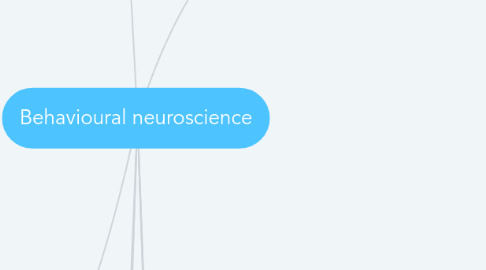
1. Lecture 1: novelty seeking(word)
2. Lecture 2: Cerebellum(word)
3. Lecture 3: Aggression and Pain (word document )
4. Lecture 4: Emotions
5. Lecture 5: Frontal lobe behaviour
5.1. First 10 minutes missed, slides until motor cortex
5.2. Frontal Lobe
5.2.1. Motor cortex
5.2.1.1. Primary motor cortex
5.2.1.1.1. Slide pathways involvement sensory information
5.2.1.2. Supplementary motor area
5.2.1.3. Premotor cortex
5.2.1.3.1. Learning and executing complex movement using sensory input. (e.g. visual dorsal and ventral stream, proprioception of the hand)
5.2.1.3.2. Direction of movement
5.2.2. Broca's area
5.2.2.1. See lecture Cerebellum
5.2.3. Frontal eye field
5.2.3.1. Focusses visual attention
5.2.3.2. controls eye movement
5.2.3.3. saccadic movements
5.2.3.3.1. jumping like movements of eyes instead of smooth moving along object.
5.2.3.4. face/emotion identification
5.2.4. Prefrontal cortex
5.2.4.1. Phineas Gage
5.2.4.1.1. Change in personality after accident
5.2.4.1.2. Most important: various aspects "animal like behaviour"
5.2.4.2. Brodmann areas
5.2.4.2.1. structural differences in layers of neocortex, 52 total specifical area's.
5.2.4.2.2. Not the same as functional structures
5.2.4.2.3. Nissil staining
5.2.4.3. Cortical types
5.2.4.3.1. Agranular
5.2.4.3.2. Dysgranular
5.2.4.3.3. ....
5.2.4.3.4. ..
5.2.4.3.5. All types of neurons are involved in prefrontal cortex
5.2.4.4. Functional division
5.2.4.4.1. NEEDED FOR ASSIGNMENT
5.2.4.4.2. Dorsolateral PFC
5.2.4.4.3. Ventral medial PFC
5.2.4.4.4. Orbitofrontal cortex
5.2.4.4.5. Anterior cingulate cortex
5.2.4.5. Executive functions
5.2.4.5.1. CEO of the brain
5.2.4.5.2. Goal directed action and adaptive responses
5.2.4.5.3. Inhibitory control
5.2.4.5.4. Working memory
5.2.4.5.5. Cognitive flexibility
5.2.4.5.6. Slide common functions
5.2.4.6. Connectivity
5.2.4.6.1. Basal ganglia, Motor cortex, Cerebellum
5.2.4.6.2. Dorsomedial thalamic nuclei (thalamus)
5.2.4.6.3. Hippocampus, MTS
5.2.4.6.4. Cingulate cortex, amygdala
5.2.4.6.5. hypothalamus
5.2.4.6.6. Brainstem nuclei
5.2.4.7. Across species
5.2.4.7.1. ......
5.2.4.8. Pruning in brain development
5.2.4.8.1. Gray matter not required are "cut out" so that more functional connections can be made.
5.2.4.8.2. Starts in the back, moves to the front
5.2.4.8.3. Quick in childhood and slows down with age. 25 PFC is fully developed.
5.2.4.8.4. Upstairs(age 7, with reason, PFC already involved) and Downstairs(age 3, no reason) tantrum limbic development.
5.2.4.8.5. Teenager years, still PFC is not controlled, risk taking behaviour related to dopamine reward system and increased hormone levels
5.2.5. Frontal lobe syndroms
5.2.5.1. Dorsolateral (dysexcutive) PFC
5.2.5.1.1. Field dependent behaviour, Do behaviour that is connected with the object that is perceived (also lack design fluency)
5.2.5.1.2. Perseverative behaviour, same behaviour time and time again
5.2.5.1.3. Personaliry changes, less emotions against environment
5.2.5.2. Orbito frontal cortex
5.2.5.2.1. Diminished concern about consequences
5.2.5.2.2. Social disinhibition and increased impulsivity
5.2.5.2.3. logorrhea (verbal diarrhea)
5.2.5.2.4. Similar to child like behaviour since they also don't have this cortex developed (most at the front?)
5.2.5.3. Ventromedial PFC
5.2.5.3.1. Decreased social emotions and empathy
5.2.5.3.2. impaired personal and social decision making.
5.2.5.4. Anterior cingulate cortex
5.2.5.4.1. Reduction/lack off speach reduction = mutism, Do not move = Akinetic
5.2.5.4.2. Abulia, lack of will/initiative and have decreased ......
5.2.5.5. Neuropsychological Tests
5.2.5.5.1. Slide, what do they measure
5.2.5.5.2. Inhibitory control test
5.2.5.5.3. Working memory
5.2.5.5.4. Cognitive flexibility
5.2.5.5.5. Names of Tests that also include other aspects that are closely related to PFC function
5.2.5.5.6. NPI
6. Lecture 6: Learning and Memory
6.1. Learning and memory are intrinsically connected
6.2. Learning
6.2.1. Definition: act/process of gaining knowledge/ skill. Induces changes in the brain
6.2.2. Easier to learn by association
6.2.3. Non associative learning
6.2.3.1. Habituation/sensitization in Aplysia/Marine slug studies
6.2.3.1.1. Identical central nervous systems
6.2.3.1.2. Withdrawal of Siphon/gill by defensive reflex. Used as readout
6.2.3.1.3. Can be used to study habituation, sensitisation, short term and long term memory.
6.2.3.1.4. Simple cellular connection model
6.2.3.2. Perceptual learning
6.2.3.2.1. Learning via all sensory systems, visual information is most effective in learning.
6.2.3.2.2. perceptual short-term memory
6.2.4. Associative learning
6.2.4.1. Classical conditioning
6.2.4.1.1. Conditioning stimulus is linked to unconditioned stimulus leading to certain response. Strengthened by repetition.
6.2.4.1.2. Basis of classical conditioning described by hebbian plasticity.
6.2.4.2. Operant conditioning
6.2.4.2.1. Association between STIMULUS and RESPONSE. REINFORCING by negative or positive stimuli.
6.2.4.2.2. Model of instrumental conditioning
6.3. Memory
6.3.1. Definition process by which what is learned pesists over time. Stored and retrieved
6.3.2. From Psychological research, described as loss of memory over time. This lead to the differentiation of 2 memory life spans (long and short), and effect of repetition increased the lifetime of memory.
6.3.2.1. Primary(short-term) memory
6.3.2.1.1. Second-minutes
6.3.2.1.2. extension of present moment
6.3.2.2. Secondary(long-term) memory
6.3.2.2.1. Weeks-month
6.3.2.2.2. can be consulted by reaching back into the past
6.3.3. Consolidation: imprinting of information in the memory
6.3.4. Learning and memory storage processes
6.3.4.1. Papez circuit
6.3.4.1.1. Partially true for declarative memory
6.3.4.2. Mishkin's circuit
6.3.4.2.1. Nuclei basalis meynert involved in AD
6.3.5. Patient H.M.
6.3.5.1. bilateral removal of medial lateral lobe, including hippocampus
6.3.5.1.1. Retrograde amnesia
6.3.5.1.2. Anterograde amnesia
6.3.5.2. Brenda miller study
6.3.5.2.1. Ability to acquire new memories, cerebral function is needed
6.3.5.2.2. Medial temporal lobes (MTLs) are not required for immediate memory
6.3.5.2.3. MTL and hippocampus are NOT the ultimate storage devices
6.3.5.2.4. Some parts of memory do not require MTLs.

